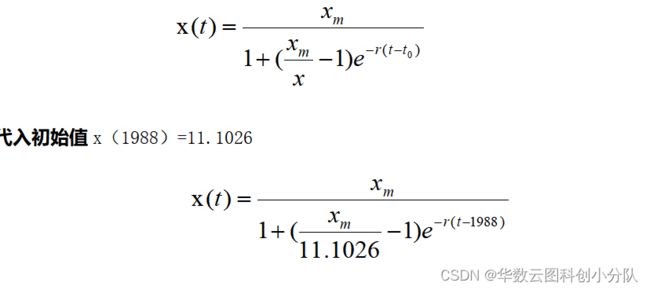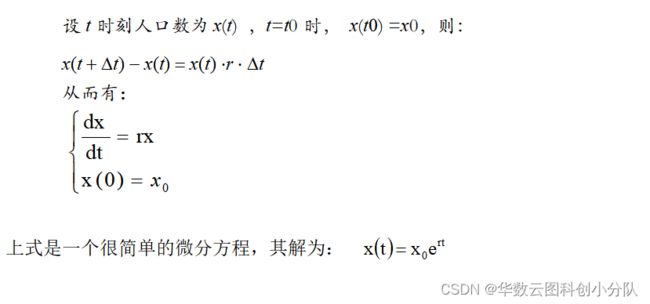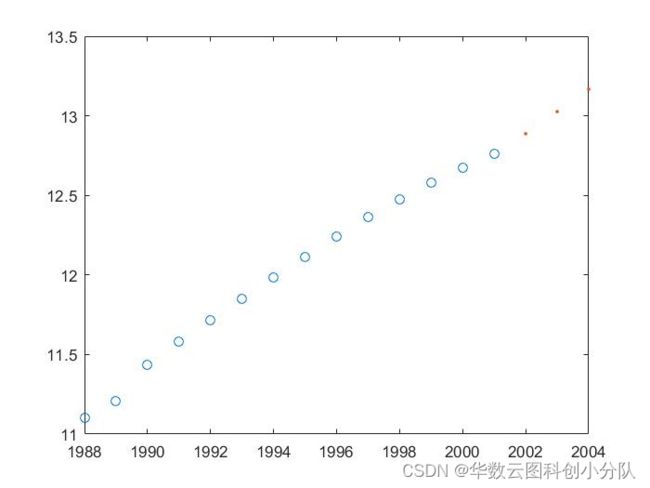数学建模-人口模型Logistic模型与 Malthus模型
一.问题及重述:下表是中国人口数据,请根据这些数据建立适当的数学模型对其进行描述,并预测2002、2003、2004年的中国人口数。
重述:
- 选取合适的模型预测2002,2003、2004年的中国人口数;
建立数学模型、给出求解代码及必要的图形,误差分析结果
| 二.问题的分析和假设: 2-1对于问题一的分析 根据题目中的数据只是一个粗略预报人口总数的模型,没有对人口的年龄、性别、地域结构进行预报,故采用Malthus模型或Logistic模型 2-2对问题二的分析 我们通过使用数学知识和matlab对以上数据进行计算,进而求解,从而得到模型以及图像。 2-3对Logistic模型的假设 (1)设r(x)为x(t)的线性单调减函数,即r(x)=r-sx(s>0); (2)自然资源与环境条件所能容纳的最大人口数为Xm,即当x=时,增长率r()=0。 由(1)、(2)可得: |
| 建模: 使用Logistic模型 上式是一个可分离变量性的微分方程,其解为: 以下对其进行拟合、求解以及绘图 |
| 求解的Matlab程序代码: 编写M文件如下: Malthus模型: 首先对数据进行拟合: >> year=1988:1:2001; >>population=[11.1026,11.2074,11.4333,11.5823,11.7171,11.8517,11.9850 12.1121,12.2389,12.3626,12.4761,12.5786,12.6743,12.7627]; >> cftool 图一 拟合数据图 Matlab自动生成的拟合代码: function [fitresult, gof] = createFit2(year, population) %CREATEFIT2(YEAR,POPULATION) % Create a fit. % % Data for 'untitled fit 1' fit: % X Input : year % Y Output: population % Output: % fitresult : a fit object representing the fit. % gof : structure with goodness-of fit info. % % 另请参阅 FIT, CFIT, SFIT. % 由 MATLAB 于 06-Apr-2022 01:20:13 自动生成 %% Fit: 'untitled fit 1'. [xData, yData] = prepareCurveData( year, population ); % Set up fittype and options. ft = fittype( 'xm/(1+(xm/11.1026-1)*exp(-r*(t-1988)))', 'independent', 't', 'dependent', 'y' ); opts = fitoptions( 'Method', 'NonlinearLeastSquares' ); opts.Display = 'Off'; opts.StartPoint = [0.2 500]; % Fit model to data. [fitresult, gof] = fit( xData, yData, ft, opts ); % Plot fit with data. figure( 'Name', 'untitled fit 1' ); h = plot( fitresult, xData, yData ); legend( h, 'population vs. year', 'untitled fit 1', 'Location', 'NorthEast' ); % Label axes xlabel year ylabel population grid on 将以上代码保存当前文件夹,并在新的文件夹中调用这个函数得到参数的拟合值和预测的效果。 计算结果与结论: 通过Matlab进行计算,得到如下答案: >> year=1988:1:2001; >>population=[11.1026,11.2074,11.4333,11.5823,11.7171,11.8517,11.9850 12.1121,12.2389,12.3626,12.4761,12.5786,12.6743,12.7627]; cftool >>[fitresult, gof] = createFit1(year, population) >>t = 2002:2004; >>xm = 14.42; >>r = 0.06451; >>predictions = xm./(1+(xm./11.1026-1).*exp(-r.*(t-1988))); >>figure(2) >>plot(year,population,'o',t,predictions,'.') >>disp(predictions) fitresult = General model: fitresult(t) = xm/(1+(xm/11.1026-1)*exp(-r*(t-1988))) Coefficients (with 95% confidence bounds): r = 0.06451 (0.05625, 0.07277) xm = 14.42 (14.03, 14.82) |
|||
| gof = sse: 0.0038 rsquare: 0.9990 dfe: 12 adjrsquare: 0.9989 rmse: 0.0179 12.8624 12.9498 13.0328 图二 人口模型预测图 结论:当t=2002 时人口为12.8624亿、t=2003时人口为12.9498亿、t=2004时人口为13.0328亿。 误差分析:查询中国人口统计图表得出2002年为12.8亿 、2003年为12.88亿、2004年为12.96亿,发现两者几乎完全一致,Logistic模型的缺点是模型中的参数r和人口总数上限xm很难准确得到,尤其是xm的值还会随着人口发展变化的情况而改变。
|








